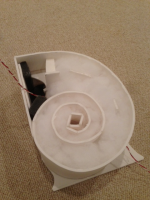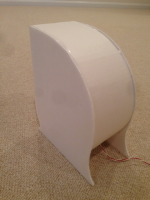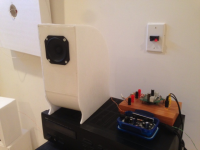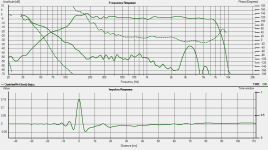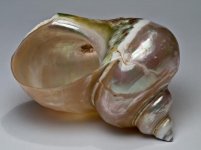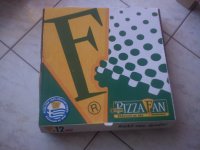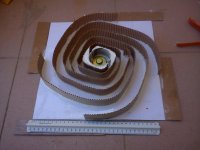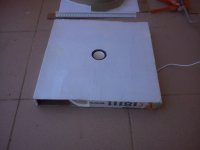Edit - Jan 12, 2014: The bottom line - here is the final in room response and THD of the Nautaloss II Reference Monitor with Subwoofer and DSP crossover. -3 dB points are 42 Hz to 18 kHz, THD is between -30 dB to -40 dB at an average of 96 dB SPL at the listening position:
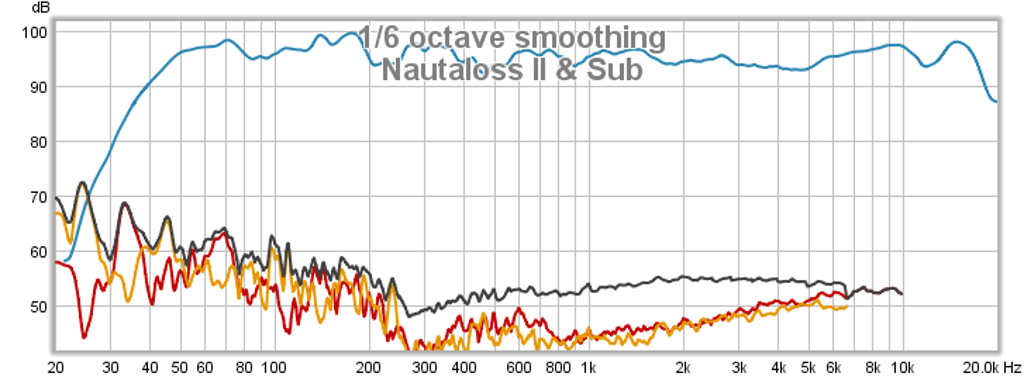
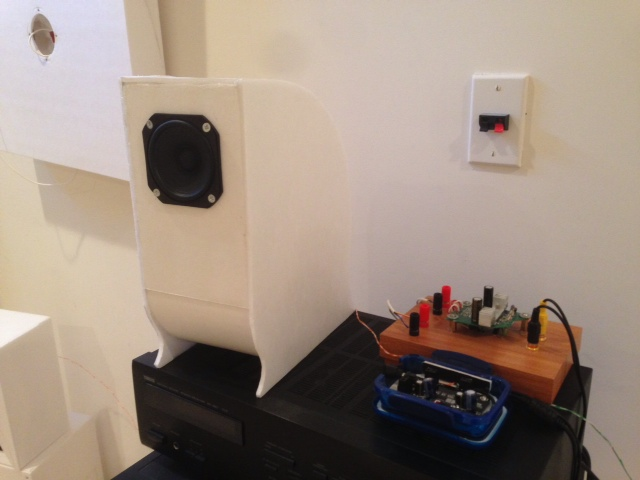
I started this speaker in the Foam Core thread (http://www.diyaudio.com/forums/full-range/223313-foam-core-board-speaker-enclosures-203.html#post3734447) on somewhat of a whim as I was inspired by the namesake speaker and wanted to try a quick and cheap foam core version to see what it may possibly sound like. (Anthonybisset is credited for coining the name)
Usually, I model and simulate a speaker pretty thoroughly before a build, but in this case, the concept was to have a spiral sealed-TL so I thought it would not be as critical as the point was to absorb the back wave and provide bass extension to as close as possible the natural fs of the driver in an open baffle. Eschewing sims, I began directly with a pencil sketch on a piece of foam core and drew an approximate 36 in long spiral that fit in a 12 in tall x 9 in deep envelope (to keep a reasonable size for a bookshelf or desktop speaker).
I then added some internal bracing at 90 deg intervals for the first 360 deg.
Then put in some speaker wire and added pillow stuffing. I glued some open cell foam around the flat areas near the front - the idea being to avoid any flat surface that could produce a back reflection or resonance that might show up on the front side of the cone. I then capped it off with a combination of hot melt and pva glue. Let it dry for 6 hours then installed the Vifa TC9FD driver.
First sound listening impressions: wow! - the clarity, transparency, and overall balance was just amazing. Although it has no bass below 150 Hz really given that the fs is 120 Hz, however this is perfect for use with a helper woofer or subwoofer crossed at about 200 to 300 Hz. The speaker really sounds good.
To confirm my suspicions that the speaker was indeed very even in character, I set out to measure it using a Panasonic WM61A mic capsule wired to my laptop soundcard. This works well below 5kHz but unfortunately cannot get anything above 6kHz due to what appears to be a low-pass filter built in to the mic input as it was designed for web chats.
The initial measurements really shocked me by how flat it was from 300 Hz on up. The measured THD was very low - I would say probably rivaling some of the very best full range drivers out there costing many times more. However, there was this pesky drop off in the response that made a cliff at 300 Hz. After scratching my head and looking at some sims in Akabak, this drop is a room-effect (distance to walls and floor).
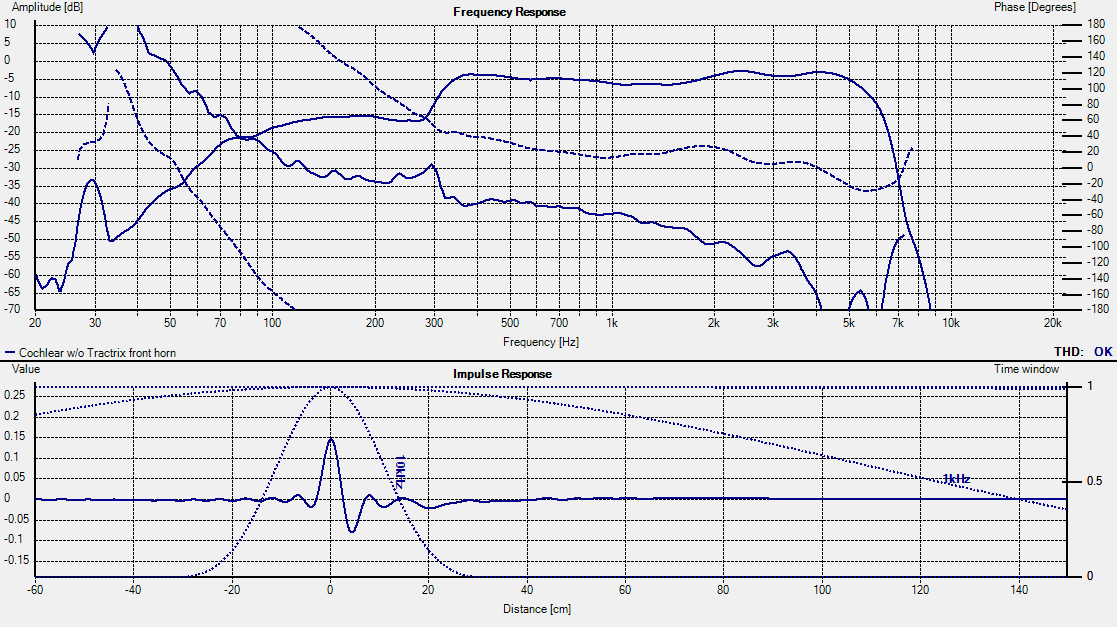
Here are sims without room reflections:
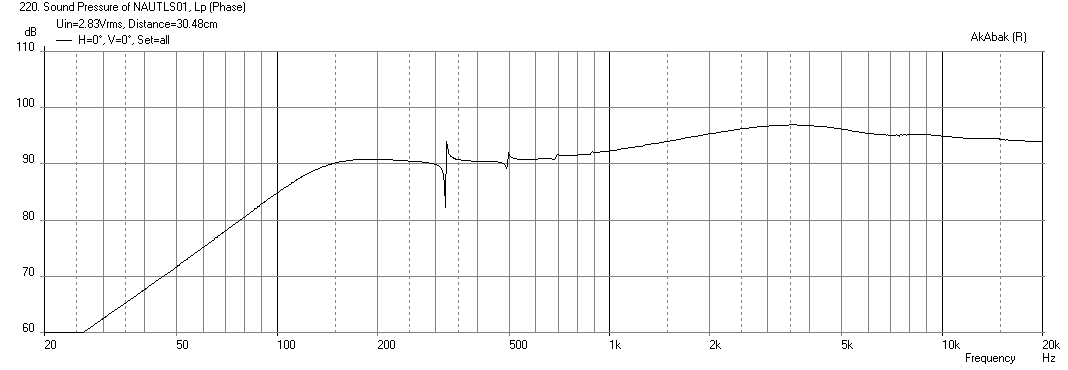
Here is the sim including rear wall at 50 inches and floor at 45 inches high:
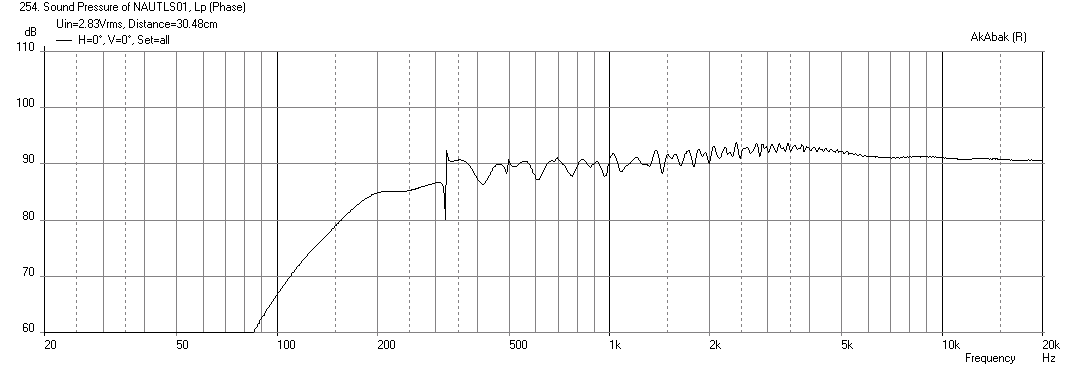
I then repeated the measurement with the same driver in an open baffle at the same location and also saw the same 300 Hz cliff, confirming that it is not the speaker enclosure (nor driver break-in) that caused this effect. The next step was to orient the speaker so that the room walls were 45 deg and I added a sheet of open cell foam and a pillow on the floor below.
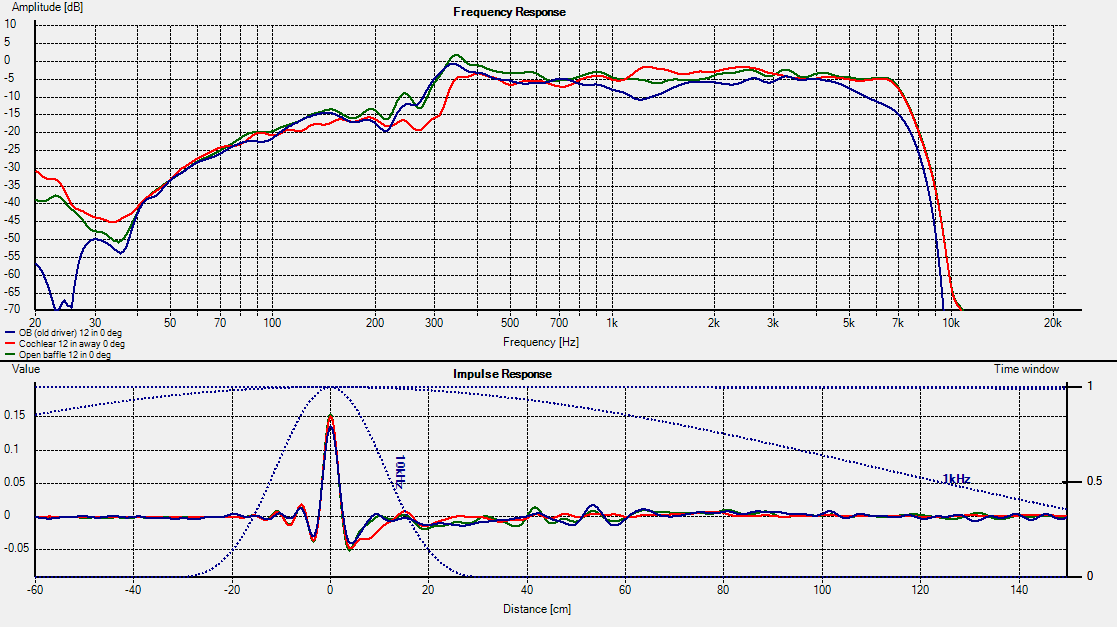
The new measurements with the room effects, now mitigated, produced a very nice frequency response curve from 150 Hz on up (I will assume that above 6 kHz the speaker performs closely along the manufacturer's published data - which is actually very flat for a full range driver). Note that from 200 Hz on up the variation in SPL is only about +/ 2 dB and the THD is typically below -50dB with a wide loaf shaped bump at about 3kHz but still very respectable. The phase variation over this range is also very linear and relatively flat. I believe, all these things point to a speaker that will sound very coherent and accurate. Finally, looking at the impulse response function, we see that this speaker has an almost ideal response function that is very clean and short with minimal ringing. This might be described as tight, clean, or fast.
Given that this speaker appears to measure very closely to an OB, I would say that the spiral is doing its job of acting like an infinite cavity by absorbing all the back wave without any reflections.
This speaker can be constructed from exactly 1 sheet of $1 foam core stock and the Vifa driver costs $10. These are not the most efficient drivers but at 85 dB for 2.83V input, they are not bad for near field use. The frequency response flatness, the low THD, the linear phase variations, and the near ideal impulse response make them perhaps one of the best values for a near field "monitor" from 200 Hz to 20 kHz.
Finally, here is the measured response with the effect of the room wall/floor bounce cancellation effect mitigated:
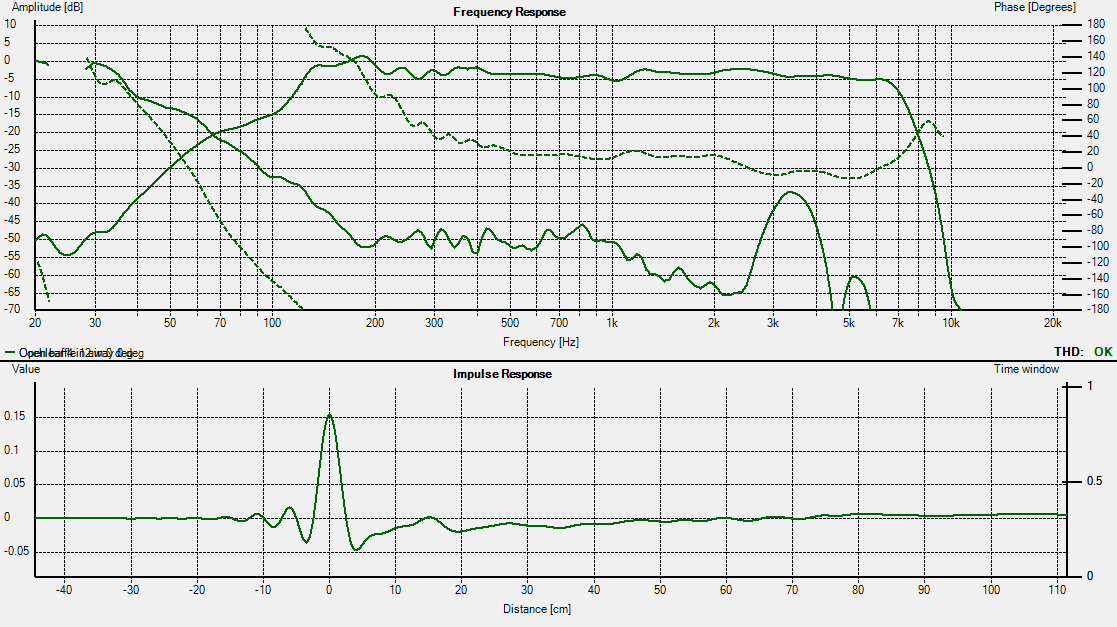
It is a fun and easy quick build. Give it a try if you are looking for a cheap but accurate speaker. This will make an excellent top for FAST system.
Cheers,
Xrk971
*** Edit (Jan 5, 2014) *** added measurements from dual driver Nautaloss II (including waterfall and spectrogram).
Nautaloss II Measurements are here: http://www.diyaudio.com/forums/full-range/247598-nautaloss-ref-monitor-11.html#post3766222
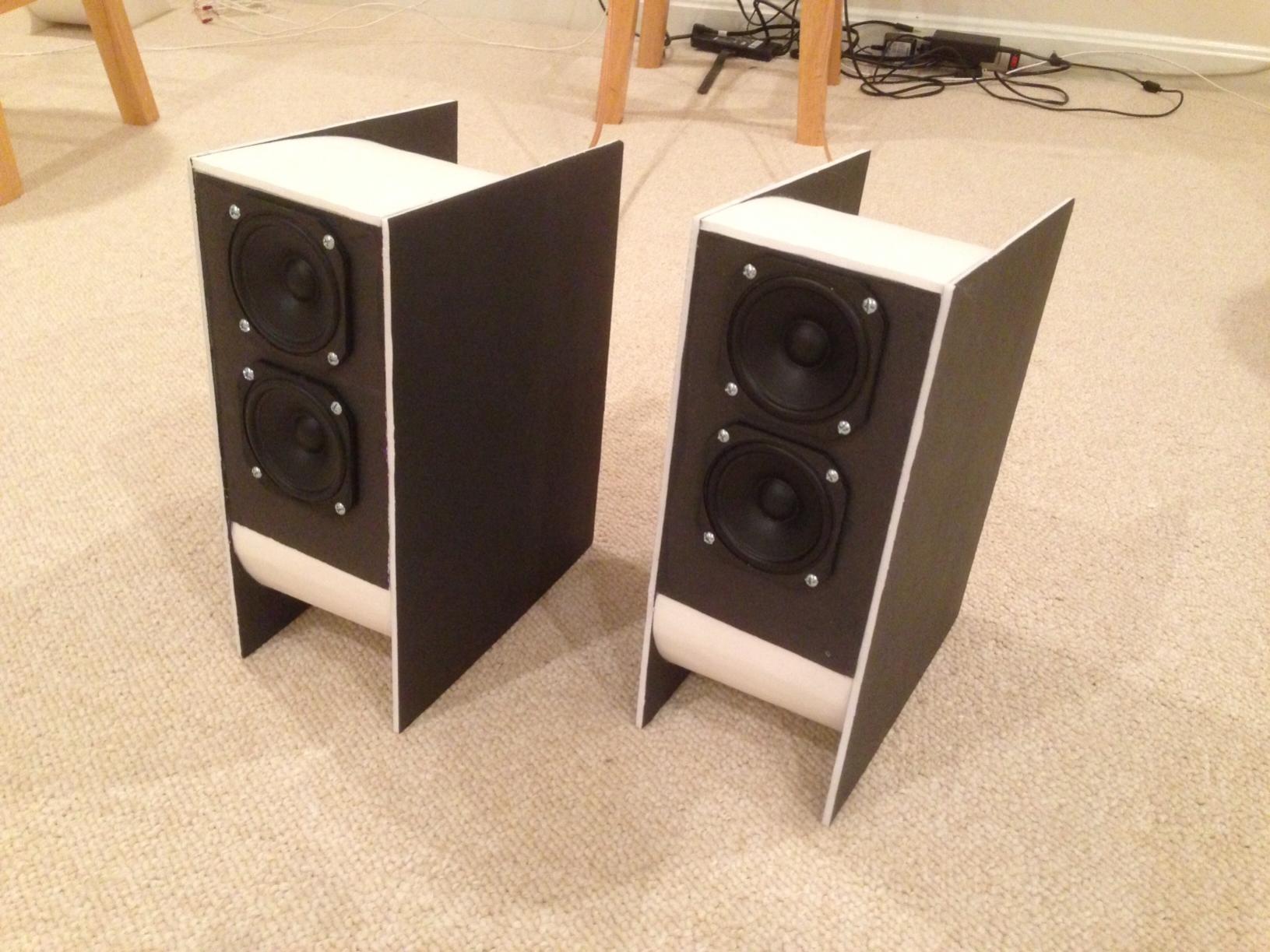
Here is the pdf plan for the Nautaloss II http://www.diyaudio.com/forums/full-range/247598-nautaloss-ref-monitor-19.html#post3788028
Freq Response is very flat from 200 hz to 18 kHz:
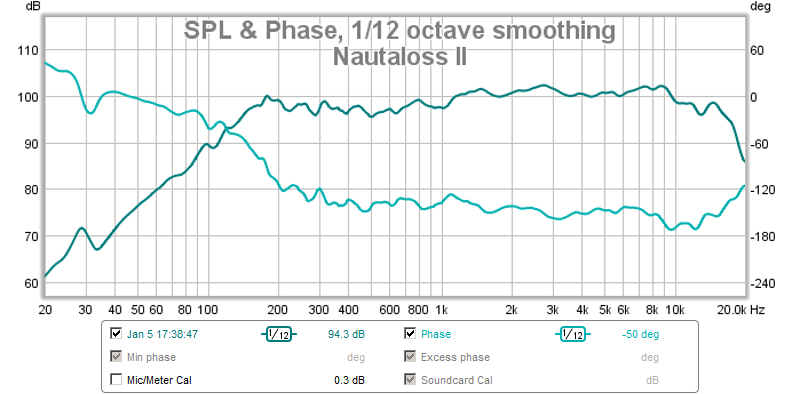
THD is -50dB!:
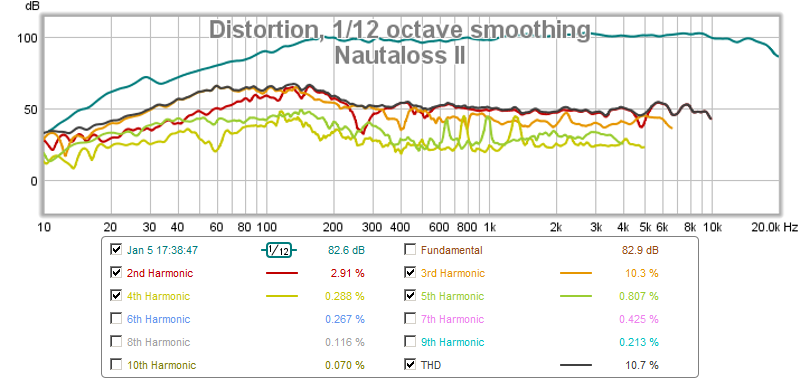
Spectral Decay:
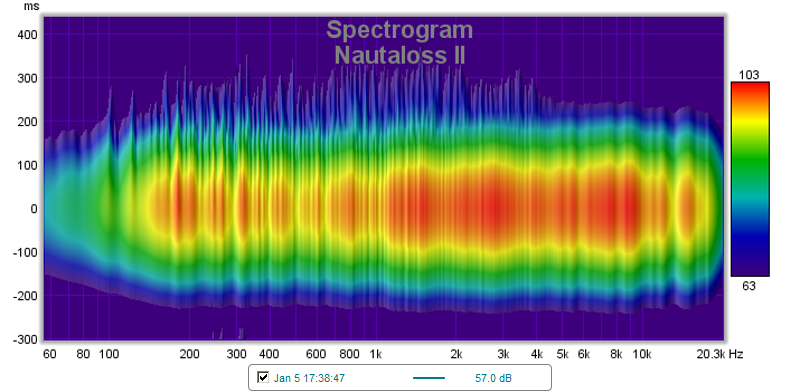


I started this speaker in the Foam Core thread (http://www.diyaudio.com/forums/full-range/223313-foam-core-board-speaker-enclosures-203.html#post3734447) on somewhat of a whim as I was inspired by the namesake speaker and wanted to try a quick and cheap foam core version to see what it may possibly sound like. (Anthonybisset is credited for coining the name)
Usually, I model and simulate a speaker pretty thoroughly before a build, but in this case, the concept was to have a spiral sealed-TL so I thought it would not be as critical as the point was to absorb the back wave and provide bass extension to as close as possible the natural fs of the driver in an open baffle. Eschewing sims, I began directly with a pencil sketch on a piece of foam core and drew an approximate 36 in long spiral that fit in a 12 in tall x 9 in deep envelope (to keep a reasonable size for a bookshelf or desktop speaker).
I then added some internal bracing at 90 deg intervals for the first 360 deg.
Then put in some speaker wire and added pillow stuffing. I glued some open cell foam around the flat areas near the front - the idea being to avoid any flat surface that could produce a back reflection or resonance that might show up on the front side of the cone. I then capped it off with a combination of hot melt and pva glue. Let it dry for 6 hours then installed the Vifa TC9FD driver.
First sound listening impressions: wow! - the clarity, transparency, and overall balance was just amazing. Although it has no bass below 150 Hz really given that the fs is 120 Hz, however this is perfect for use with a helper woofer or subwoofer crossed at about 200 to 300 Hz. The speaker really sounds good.
To confirm my suspicions that the speaker was indeed very even in character, I set out to measure it using a Panasonic WM61A mic capsule wired to my laptop soundcard. This works well below 5kHz but unfortunately cannot get anything above 6kHz due to what appears to be a low-pass filter built in to the mic input as it was designed for web chats.
The initial measurements really shocked me by how flat it was from 300 Hz on up. The measured THD was very low - I would say probably rivaling some of the very best full range drivers out there costing many times more. However, there was this pesky drop off in the response that made a cliff at 300 Hz. After scratching my head and looking at some sims in Akabak, this drop is a room-effect (distance to walls and floor).

Here are sims without room reflections:

Here is the sim including rear wall at 50 inches and floor at 45 inches high:

I then repeated the measurement with the same driver in an open baffle at the same location and also saw the same 300 Hz cliff, confirming that it is not the speaker enclosure (nor driver break-in) that caused this effect. The next step was to orient the speaker so that the room walls were 45 deg and I added a sheet of open cell foam and a pillow on the floor below.

The new measurements with the room effects, now mitigated, produced a very nice frequency response curve from 150 Hz on up (I will assume that above 6 kHz the speaker performs closely along the manufacturer's published data - which is actually very flat for a full range driver). Note that from 200 Hz on up the variation in SPL is only about +/ 2 dB and the THD is typically below -50dB with a wide loaf shaped bump at about 3kHz but still very respectable. The phase variation over this range is also very linear and relatively flat. I believe, all these things point to a speaker that will sound very coherent and accurate. Finally, looking at the impulse response function, we see that this speaker has an almost ideal response function that is very clean and short with minimal ringing. This might be described as tight, clean, or fast.
Given that this speaker appears to measure very closely to an OB, I would say that the spiral is doing its job of acting like an infinite cavity by absorbing all the back wave without any reflections.
This speaker can be constructed from exactly 1 sheet of $1 foam core stock and the Vifa driver costs $10. These are not the most efficient drivers but at 85 dB for 2.83V input, they are not bad for near field use. The frequency response flatness, the low THD, the linear phase variations, and the near ideal impulse response make them perhaps one of the best values for a near field "monitor" from 200 Hz to 20 kHz.
Finally, here is the measured response with the effect of the room wall/floor bounce cancellation effect mitigated:

It is a fun and easy quick build. Give it a try if you are looking for a cheap but accurate speaker. This will make an excellent top for FAST system.
Cheers,
Xrk971
*** Edit (Jan 5, 2014) *** added measurements from dual driver Nautaloss II (including waterfall and spectrogram).
Nautaloss II Measurements are here: http://www.diyaudio.com/forums/full-range/247598-nautaloss-ref-monitor-11.html#post3766222

Here is the pdf plan for the Nautaloss II http://www.diyaudio.com/forums/full-range/247598-nautaloss-ref-monitor-19.html#post3788028
Freq Response is very flat from 200 hz to 18 kHz:

THD is -50dB!:

Spectral Decay:

Attachments
Last edited:
this is interesting actually as i'm wondering if it would be worth my effort trying to design something like this for a 15" bass driver.
have you ever investigated how much of an effect the 'lossy' nature of foam core can be improved by bracing the hell out of it? the side wall will be braced by the spiral, would it make an difference adding some lateral bracing to the spiral structure horizontallu?
i do like reading your experiments, some of the results are much better then i would have ever expected!
have you ever investigated how much of an effect the 'lossy' nature of foam core can be improved by bracing the hell out of it? the side wall will be braced by the spiral, would it make an difference adding some lateral bracing to the spiral structure horizontallu?
i do like reading your experiments, some of the results are much better then i would have ever expected!
Gaffhenderson,
Thanks! If you do this for a 15 in bass driver, you get the B&W Nautilus bass unit I think it will provide very clean bass - perhaps as clean as you can hope to achieve impulse response wise and flat freq response wise. I actually braced in both directions (radially and laterally) - can't see it since stuffing covers it. Since I am using a high Qts driver, the lossy structure actually helps to smooth out the peakyness that would otherwise show up with a stiff structure. Get me your driver params and I can run a sim for you if you tell me how long of a spiral you want to make.
I think it will provide very clean bass - perhaps as clean as you can hope to achieve impulse response wise and flat freq response wise. I actually braced in both directions (radially and laterally) - can't see it since stuffing covers it. Since I am using a high Qts driver, the lossy structure actually helps to smooth out the peakyness that would otherwise show up with a stiff structure. Get me your driver params and I can run a sim for you if you tell me how long of a spiral you want to make.
Thanks! If you do this for a 15 in bass driver, you get the B&W Nautilus bass unit
Gaffhenderson,
Thanks! If you do this for a 15 in bass driver, you get the B&W Nautilus bass unitI think it will provide very clean bass - perhaps as clean as you can hope to achieve impulse response wise and flat freq response wise. I actually braced in both directions (radially and laterally) - can't see it since stuffing covers it. Since I am using a high Qts driver, the lossy structure actually helps to smooth out the peakyness that would otherwise show up with a stiff structure. Get me your driver params and I can run a sim for you if you tell me how long of a spiral you want to make.
AE TD15M.
sealed volume is around 86-87ltr for 0.7q
AE TD15M.
sealed volume is around 86-87ltr for 0.7q
Considering it would have f3=80Hz doing so, it might be quite the decent system with subwoofers or even by itself corner-loaded depending on one's tastes. I'm using a pair in vented enclosures, almost overdamped alignments, but would go for sealed were I to use actual subwoofers. I'd like to see how sealed compares to a lossy spiral.
BTW, stick a ~60Hz high-pass on the sealed TD15M and power handling will be close to thermally-limited and we're past 120dB by then.
IG
Last edited:
Considering it would have f3=80Hz doing so, it might be quite the decent system with subwoofers or even by itself corner-loaded depending on one's tastes. I'm using a pair in vented enclosures, almost overdamped alignments, but would go for sealed were I to use actual subwoofers. I'd like to see how sealed compares to a lossy spiral.
BTW, stick a ~60Hz high-pass on the sealed TD15M and power handling will be close to thermally-limited and we're past 120dB by then.
IG
Using mjks sheets, using a port with zero output Via heavy dampening and minimal actual volume, corner placement shows a pretty flat response down in the 40s.
This is a few feet away from walls but the low end boosts quite considerably when tucked in. The time delay is what draws me to this. The more I can remove unwanted rear waves with a spiral the better!
An externally hosted image should be here but it was not working when we last tested it.
Using mjks sheets, using a port with zero output Via heavy dampening and minimal actual volume, corner placement shows a pretty flat response down in the 40s.
This is a few feet away from walls but the low end boosts quite considerably when tucked in. The time delay is what draws me to this. The more I can remove unwanted rear waves with a spiral the better!
Yeah, ~80Hz is the standard half-space response used by WinISD. Getting into the 40ies with a corner would be nice indeed.
IG
AE TD15M.
sealed volume is around 86-87ltr for 0.7q
I am having a hard time getting a low Qts driver like this to work well. This enclosure "feels" like an OB to the driver so you want a higher Qts driver if you want deeper flat bass extension. Are you opposed to something like the Eminence Beta 15A? Similar efficiency, 11.6mm xmax, probably costs less. Works much better in a sealed TL Nautaloss.
I am having a hard time getting a low Qts driver like this to work well. This enclosure "feels" like an OB to the driver so you want a higher Qts driver if you want deeper flat bass extension. Are you opposed to something like the Eminence Beta 15A? Similar efficiency, 11.6mm xmax, probably costs less. Works much better in a sealed TL Nautaloss.
Main concern is the sound quality. Sealed + linkwitz transform looks to be the way to go for me. It's what to do with the backwave now. The spiral tl effectively dissipates it.
What's your best effort with AE TD15M and the eminence?
Hi,
I'm not knocking the approach, but will just point out to be a lot better
than say just a well stuffed sealed box with angled diffusor panels
the line needs denser stuffing as you go along it to work well.
rgds, sreten.
Its pretty much a waste of time with a 15" driver,
unless you like pointlessy complicated huge boxes.
I'm not knocking the approach, but will just point out to be a lot better
than say just a well stuffed sealed box with angled diffusor panels
the line needs denser stuffing as you go along it to work well.
rgds, sreten.
Its pretty much a waste of time with a 15" driver,
unless you like pointlessy complicated huge boxes.
Last edited:
I agree and I actually use denser stuffing as the CSA gets smaller. For a 15 in driver, the path actually doesn't need to be that long as it is acting as a terminal energy absorber rather than a resonant TL. I am getting paths of about 5 ft long as an ideal length, which is not that many turns on a spiral.
Bass Nautaloss with Beta 15A
Here are the results with the Beta 15A driver. I am using a 56 in long path with a 16 in wide cabinet. I have not wrapped up the coil to see how big cabinet will be but I am guessing about 40 in tall x 30 in deep. If you mount the driver near the floor and aim the coil up, you get floor bass enhancement. I am including a 35 Hz 2nd order high pass filter, and a 1mH+4ohm resistor for BSC.
Here is the freq response with no reflections from walls or floor:

If you place speaker 60 in away from back wall and assume the driver centerline is 9 in above the floor, here is the frequency response - this may work well to cross-over with the top horn at about 1kHz:

Impedance and Electrical Phase:

Max Cone Displacement is at 16 volts (good for 112 dB):

Impulse Response:

Main concern is the sound quality. Sealed + linkwitz transform looks to be the way to go for me. It's what to do with the backwave now. The spiral tl effectively dissipates it.
What's your best effort with AE TD15M and the eminence?
Here are the results with the Beta 15A driver. I am using a 56 in long path with a 16 in wide cabinet. I have not wrapped up the coil to see how big cabinet will be but I am guessing about 40 in tall x 30 in deep. If you mount the driver near the floor and aim the coil up, you get floor bass enhancement. I am including a 35 Hz 2nd order high pass filter, and a 1mH+4ohm resistor for BSC.
Here is the freq response with no reflections from walls or floor:

If you place speaker 60 in away from back wall and assume the driver centerline is 9 in above the floor, here is the frequency response - this may work well to cross-over with the top horn at about 1kHz:

Impedance and Electrical Phase:

Max Cone Displacement is at 16 volts (good for 112 dB):

Impulse Response:

Attachments
-
 Nautaloss-Bass-Beta=15A-Impulse.png11.9 KB · Views: 3,902
Nautaloss-Bass-Beta=15A-Impulse.png11.9 KB · Views: 3,902 -
 Nautaloss-Bass-Beta=15A-Max-Displ.png19.4 KB · Views: 3,927
Nautaloss-Bass-Beta=15A-Max-Displ.png19.4 KB · Views: 3,927 -
 Nautaloss-Bass-Beta=15A-Impedance.png18.9 KB · Views: 3,948
Nautaloss-Bass-Beta=15A-Impedance.png18.9 KB · Views: 3,948 -
 Nautaloss-Bass-Beta=15A-Freq-1m.png19.5 KB · Views: 3,961
Nautaloss-Bass-Beta=15A-Freq-1m.png19.5 KB · Views: 3,961 -
 Nautaloss-Bass-Beta=15A-Freq-1m-no-reflections.png18.7 KB · Views: 3,957
Nautaloss-Bass-Beta=15A-Freq-1m-no-reflections.png18.7 KB · Views: 3,957
Sound Clips of Nautaloss in Stereo
I just finished the second unit and had a listen. The imaging, transparency, and sound stage are superb. The speakers disappear and you can visualize the phantom stereo image in your mind. Here are a couple of test tracks, there is some background noise from the nearby furnace which raises the noise floor a bit. Also, the room is square in shape and sparsely furnished so there may be some reverberations. I am running the speakers full range and also driving an old band-pass sub full range as I do not have the PLLXO built yet. I plan to get a better sub woofer in the future but this will have to do for now.
Let me know what you think of the sound.
I just finished the second unit and had a listen. The imaging, transparency, and sound stage are superb. The speakers disappear and you can visualize the phantom stereo image in your mind. Here are a couple of test tracks, there is some background noise from the nearby furnace which raises the noise floor a bit. Also, the room is square in shape and sparsely furnished so there may be some reverberations. I am running the speakers full range and also driving an old band-pass sub full range as I do not have the PLLXO built yet. I plan to get a better sub woofer in the future but this will have to do for now.
Let me know what you think of the sound.
Attachments
Hi xrk971
Yes, the fantastic cornus! I built a pair out of small pizza boxes, they sound splendid when hanged on the wall but I haven’t done any measurements on them yet (I am drown into other projects).
The shell speakers were carried away by my younger daughter. She used them with her tablet. Tinny units and beautiful, no measurements for them either. I don’t know if she still has them.
Keep on the good work
George
Yes, the fantastic cornus! I built a pair out of small pizza boxes, they sound splendid when hanged on the wall but I haven’t done any measurements on them yet (I am drown into other projects).
The shell speakers were carried away by my younger daughter. She used them with her tablet. Tinny units and beautiful, no measurements for them either. I don’t know if she still has them.
Keep on the good work

George
Attachments
Here is the AE TD15M in the same exact enclosure as above. Optimizing lengths, taper, volume, etc did not help much.
That's not so bad on face value as the baffle will help, which that akabak script doesn't have on it currently? Its definitely an idea I think I'll have a play with, just to see if it helps reduce the noise level or time smear of a plain sealed box. Buying a woofer with such low THD like the acoustic elegance woofers, it makes sense to do every thing you can to maintain the system as clean as possible.
Bass Nautaloss with AE TD15M in a Corner
Gafhenderson,
OK, I put in a 16 in wide x 36 in tall x 30 in deep box with the driver centered 9 in from the floor. The speaker is angled at 45 deg out of a corner with the walls 28 in away from the front baffle on either side. There is quite a bit of bass enhancement from the corner and floor but also a lot of wall/floor induced bounce cancellation. This helps bring the -3 dB point for bass extension down to about 36 Hz with an average sensitivity of about 95dB at 2.83V (average value based on middle of dips caused by room reflection). The main attraction is the elimination of the back wave - which you can only see in the "no-reflection" case above.
with an average sensitivity of about 95dB at 2.83V (average value based on middle of dips caused by room reflection). The main attraction is the elimination of the back wave - which you can only see in the "no-reflection" case above.
SPL Freq Response at 2.83V:

Impedance:

Max Cone Displacement:

SPL at xmax (26V rms):

I hope you build it. I will provide details of the spiral geometry if you are interested in going further.
Regards,
X
That's not so bad on face value as the baffle will help, which that akabak script doesn't have on it currently? Its definitely an idea I think I'll have a play with, just to see if it helps reduce the noise level or time smear of a plain sealed box. Buying a woofer with such low THD like the acoustic elegance woofers, it makes sense to do every thing you can to maintain the system as clean as possible.
Gafhenderson,
OK, I put in a 16 in wide x 36 in tall x 30 in deep box with the driver centered 9 in from the floor. The speaker is angled at 45 deg out of a corner with the walls 28 in away from the front baffle on either side. There is quite a bit of bass enhancement from the corner and floor but also a lot of wall/floor induced bounce cancellation. This helps bring the -3 dB point for bass extension down to about 36 Hz
SPL Freq Response at 2.83V:

Impedance:

Max Cone Displacement:

SPL at xmax (26V rms):

I hope you build it. I will provide details of the spiral geometry if you are interested in going further.
Regards,
X
Attachments
Last edited:
- Home
- Loudspeakers
- Full Range
- The Nautaloss Ref Monitor
